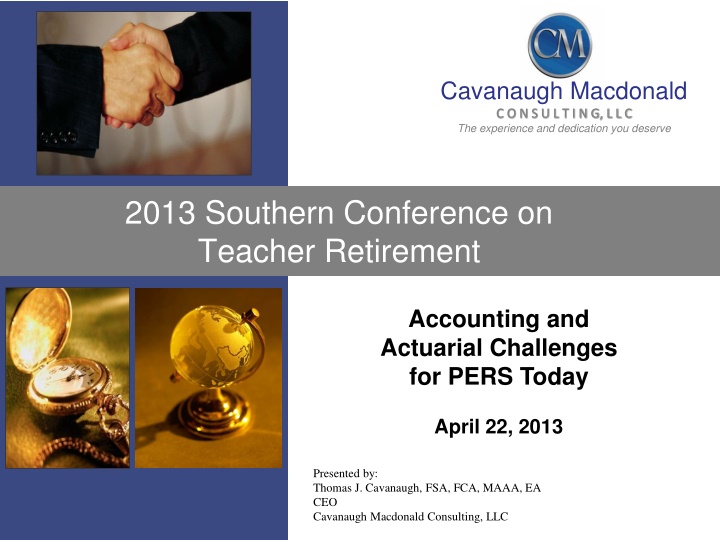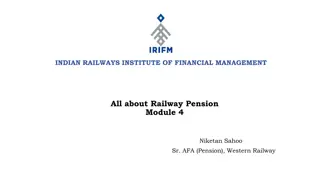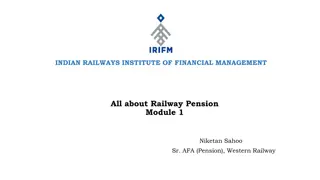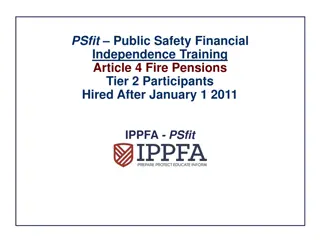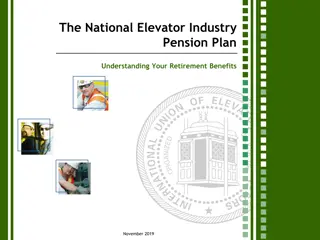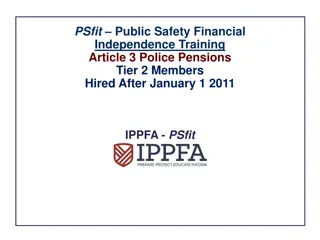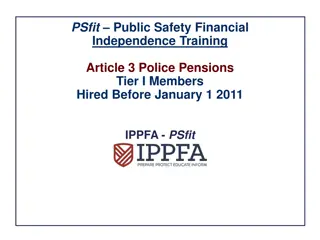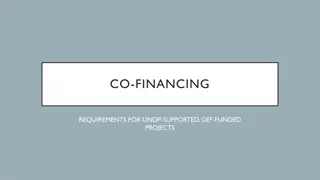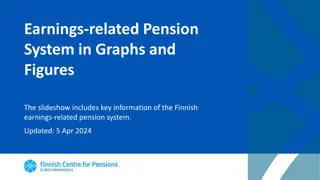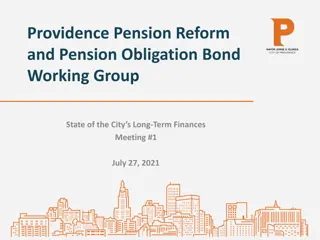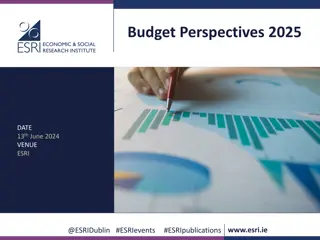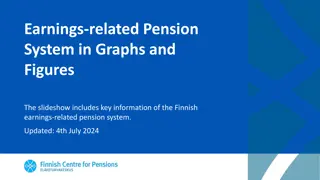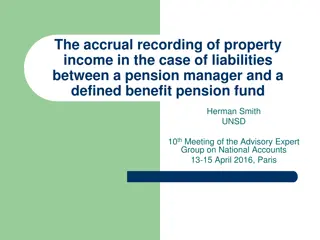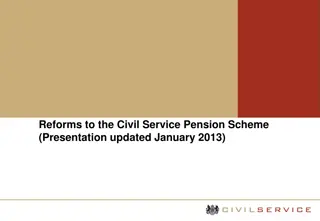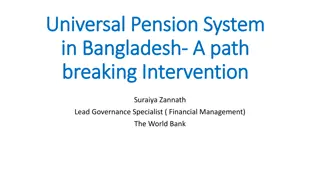Evolution of Public Pension Financing: A Historical Overview
Explore the historical evolution of public pension financing from the 1970s to today, highlighting key trends in actuarial practices, funding policies, asset allocation, and the roles of actuaries and accountants. Gain insights into the changes shaping the landscape of pension planning and management.
Download Presentation

Please find below an Image/Link to download the presentation.
The content on the website is provided AS IS for your information and personal use only. It may not be sold, licensed, or shared on other websites without obtaining consent from the author.If you encounter any issues during the download, it is possible that the publisher has removed the file from their server.
You are allowed to download the files provided on this website for personal or commercial use, subject to the condition that they are used lawfully. All files are the property of their respective owners.
The content on the website is provided AS IS for your information and personal use only. It may not be sold, licensed, or shared on other websites without obtaining consent from the author.
E N D
Presentation Transcript
Cavanaugh Macdonald C O N S U L T I N G, L L C The experience and dedication you deserve 2013 Southern Conference on Teacher Retirement Accounting and Actuarial Challenges for PERS Today April 22, 2013 Presented by: Thomas J. Cavanaugh, FSA, FCA, MAAA, EA CEO Cavanaugh Macdonald Consulting, LLC
Actuarial Issues GASB s authority extends only to accounting and financial reporting, not to funding. New Statements necessitate a fresh look at funding policies and actuarial techniques. Projections will play a bigger role going forward, particularly for all the plans with multiple benefit tiers. 2
Pension Expense as Funding Level? The simple answer is NO! New funding guidelines will have to be developed for plans. The PE cannot be used as it is a backwards looking number and it tends to generate much greater volatility. In addition it could be an income item, and funds cannot be withdrawn from the trust. 3
Evolution of Modern Public Pension Plan Financing 1970 - Today 1970s the decade of the actuary Beginning of automatic cost-of-living adjustments (COLAs). Social Security s COLA was effective in 1975. Move to higher equity participation by plans. For some plans it was the beginning of equity investments. 4
State and Local Government Asset Allocation (Federal Reserve Board of Governors Flow of Funds 1955 4th Qtr 2012) 0.8 0.7 0.6 0.5 Gov't Securities Corp Bonds Equities 0.4 0.3 0.2 0.1 0 1955 1959 1963 1971 1975 1979 1983 1987 1991 1995 2003 2007 2011 1967 1999 5
Evolution of Modern Public Pension Plan Financing 1970 - Today 1980s and 1990s decades of the investment consultant Increased equity participation. Previous slide shows increase from 22% in 1980 to 64% in 2000. Great total fund returns. Actuaries took a back seat as funding got easier and easier . 6
Evolution of Modern Public Pension Plan Financing 1970 - Today Late 1990s and 2000s the decade plus of the accountant GASB issues Statements 25 and 27 setting de facto funding standards via the Annual Required Contribution (ARC). Actuaries (who were already in the back seat ) moved to the trunk. Actuaries took the easy way out and blamed everything on the accountants (and to some degree we re going to keep doing that!) 7
Evolution of Modern Public Pension Plan Financing 1970 - Today 2010s and later (?) decades of the actuary GASB has abdicated any role in funding guidance. They now just want a spreadsheet number or two. Investment consultants are in a defensive posture as returns are low. Actuaries have to step (and are stepping) back up to the plate. American Academy of Actuaries Public Plans Subcommittee Conference of Consulting Actuaries Public Plans Community California Actuarial Advisory Panel issued Actuarial Funding Policies and Practices for Public Pension and OPEB Plans February 2013 Model practices Acceptable practices Acceptable practices, with conditions Non-recommended practices Unacceptable practices 8
Need for a Funding Policy Pre-funding is less expensive over the long term than pay-as-you-go. It provides retirement security. It s consistent with accrual accounting. A funding policy statement describes how the Board of Trustees intends to provide secure retirement benefits. Its development will increase the Board s understanding of the risks involved and the underlying actuarial funding principles. 9
Funding Policy Structure There are normally three major components of a funding policy statement: Funding Goals Benchmarks Methods and Assumptions 10
Funding Goals The goals describe the objectives the Board has in funding the benefits. Some common goals are: Full funding (100% funded ratio) Contribution rate stability Intergenerational equity Targeted funding ratio, either greater than or less than 100% 11
Benchmarks The benchmarks indicate how progress toward meeting the stated goals with be measured. They can include: Funding ratio Experience test (ratio of net gain/loss to accrued liability over time) Short condition test (assets compared to retiree liability and active member contribution balances) Contribution rate history UAAL amortization period 12
Methods and Assumptions The following elements are usually addressed in funding policy statements: Actuarial cost method Asset smoothing method Amortization of Unfunded Actuarial Accrued Liability (UAAL) policy Funding target 13
Actuarial Cost Method Still several acceptable methods Entry Age Normal Projected Unit Credit Aggregate Frozen Initial Liability 14
Asset Smoothing Method Issues include: Length of smoothing period. Corridor and, if one, it s size. Fixed or rolling smoothing periods. ASOP 44 requires a method that: Is likely to return to market in a reasonable period and likely to stay within a reasonable range of market, or Has a sufficiently short period to return to market or sufficiently narrow range around market. 15
Amortization of UAAL Open or closed period. Level percent of payroll or level dollar. Separate amortization by source of UAAL. Length of amortization period. Somewhat dependent on whether employer contribution rates are fixed or not. 16
Funding Target The ultimate funding target should be 100% or more at some point in the future. How that is accomplished and over what timeframe will be dependent on both statutory restrictions and the funding goals established by the Board during the policy setting process. Projections can play a major role in measuring progress toward whatever funding goal is established, particularly with tiered benefits. 18
Projections and Tiered Benefits It s common now to have two or more tiers of benefits in public plans. This creates a front-loaded benefit structure and potentially a back-loaded contribution structure. The front-loading is fairly obvious as new tiers provide lower benefits to new hires than previous tiers do. The back-loading can occur for plans that contribute a fixed or increasing employer contribution rate, either by statute or by policy. 19
About Projections Annual actuarial valuations are a snapshot of the financial position on the valuation date, based on the existing active and retired members. Projections simulate future actuarial valuation results over a forecast period (generally 20-50 years depending on the situation) by creating future new hires and performing valuations using the projected membership. Benefit changes from new tiers are reflected for the affected employee groups as they become effective. Deterministic projections use one set of demographic and economic assumptions over the projection period. Stochastic projections provide results of thousands of runs under randomly determined assumptions (usually economic). Projections provide information on trends in financial measurements. They do not provide absolute results. 20
Discount Rate Comparison Funded Ratio - PERS Mississippi PERS - PERS Plan 30-Year Projection of Funded Ratio on Actuarial Asset Value Based on June 30, 2012 Valuation Results 100% 95% 90% 85% Funded Ratio 80% 75% 70% 65% 60% 55% 50% 2012 2014 2016 2018 2020 2022 2024 2026 2028 2030 2032 2034 2036 2038 2040 2042 Year Beginning 8% 7.75% 7.50% 21
Discount Rate Comparison Amortization Period - PERS Mississippi PERS - PERS Plan 30-Year Projection of Amortization Period Based on June 30, 2012 Valuation Results 50 45 40 35 Amortization Period Remaining 30 25 20 15 10 5 0 2012 2014 2016 2018 2020 2022 2024 2026 2028 2030 2032 2034 2036 2038 2040 2042 Year Beginning 8% 7.75% 7.50% 22
Colorado PERA - State Division 30-Year Projection of Funded Ratio on Actuarial Asset Value Based on December 31, 2011 Valuation Results 160% 140% 120% 100% Funded Ratio % 80% 60% 40% 20% 0% 2012 2013 2014 2015 2016 2017 2018 2019 2020 2021 2022 2023 2024 2025 2026 2027 2028 2029 2030 2031 2032 2033 2034 2035 2036 2037 2038 2039 2040 2041 2042 Last Year Valuation 58% 60% 60% 60% 60% 59% 59% 59% 59% 59% 59% 58% 58% 58% 58% 58% 58% 58% 58% 59% 59% 60% 61% 62% 63% 65% 67% 69% 72% 75% 79% Expected Return 8.00% 58% 58% 57% 56% 56% 55% 55% 54% 54% 54% 53% 53% 52% 52% 52% 51% 51% 51% 51% 51% 51% 51% 52% 53% 54% 55% 57% 59% 61% 64% 68% Pessimistic Return 6.50% 58% 58% 57% 55% 53% 52% 51% 49% 48% 46% 45% 43% 41% 39% 37% 36% 34% 32% 30% 28% 26% 24% 22% 21% 19% 18% 17% 16% 15% 15% 15% Optimistic Return 9.50% 58% 58% 58% 57% 58% 59% 59% 60% 61% 62% 63% 64% 66% 67% 69% 71% 73% 75% 78% 81% 85% 89% 93% 98% 104% 110% 117% 124% 132% 141% 149% Year Beginning Last Year Valuation Expected Return 8.00% Pessimistic Return 6.50% Optimistic Return 9.50% 23
Colorado PERA - State Division 30-Year Projection of Amortization Period Based on December 31, 2011 Valuation Results 120 90 Amortization Period Remaining 60 30 0 2012 2013 2014 2015 2016 2017 2018 2019 2020 2021 2022 2023 2024 2025 2026 2027 2028 2029 2030 2031 2032 2033 2034 2035 2036 2037 2038 2039 2040 2041 2042 Last Year Valuation 54 43 37 34 31 28 28 27 27 26 25 24 23 22 21 20 19 18 17 16 15 14 13 11 10 9 8 7 6 5 4 Expected Return 8.00% 56 48 43 40 36 32 32 31 30 29 28 27 26 25 24 23 22 21 20 18 17 16 15 14 13 11 10 9 8 7 6 Pessimistic Return 6.50% 56 48 44 42 39 37 37 38 38 39 39 39 39 38 38 37 36 35 35 33 32 31 30 29 27 26 25 23 22 21 20 Optimistic Return 9.50% 56 47 41 37 32 28 27 25 23 22 20 18 17 15 13 12 10 9 7 6 4 3 2 0 0 0 0 0 0 0 0 Year Beginning Last Year Valuation Pessimistic Return 6.50% Expected Return 8.00% Optimistic Return 9.50% 24
Stochastic Projection Results Funded Ratios Funded Ratio Baseline (left) vs. Alternative 1 (right) 300 281.8 250 200 188.1 Percent 163.5 150 132.4 121.9 120.4 113.7 100 100.7 92.9 96.9 91.2 86.0 83.3 72.0 80.3 69.3 75.7 64.2 57.8 57.2 55.0 50 50.0 48.8 35.1 23.2 21.9 14.6 9.0 0 - - 2011 2021 2031 25
Stochastic Projection Results Contribution Rates Actuarial Contribution Rate Alternative 1 (solid) vs. Baseline (dotted) 40% 35% 95th Percentile 30% 75th Percentile 25% 20% 50th Percentile 15% 10% 25th Percentile 5% 0% 2002 5th Percentile 2004 2006 2008 2010 2012 2014 2016 2018 2020 2022 2024 2026 2028 2030 26
Final Thoughts Unlock your trunk and let your actuary out! Develop a funding policy now to address the need you will have once GASB 67/68 are effective. Valuations are fine but projections are finer. Consider adding them to the annual flow of information from your actuary. 27
